Open and write data to text file using Bash?
Categories:
Mastering Text File Operations in Bash: Open, Write, and Append Data

Learn how to effectively open, write, and append data to text files using various Bash commands and techniques. This guide covers redirection, here documents, and common pitfalls.
Working with text files is a fundamental task in Bash scripting and command-line operations. Whether you need to log output, store configuration, or process data, Bash provides powerful and flexible tools for interacting with files. This article will guide you through the essential commands and techniques to open, write, and append data to text files, ensuring you can manage your data efficiently.
Writing and Overwriting Files with Redirection
The most common way to write data to a file in Bash is using output redirection. The > operator redirects the standard output of a command to a specified file. If the file does not exist, it will be created. If the file already exists, its contents will be completely overwritten. This is crucial to remember to avoid accidental data loss.
echo "Hello, World!" > myfile.txt
cat myfile.txt
echo "This will overwrite the previous content." > myfile.txt
cat myfile.txt
Writing and overwriting a file using the > operator.
> operator, as it will silently overwrite existing files. If you want to prevent accidental overwrites, you can set the noclobber option in your shell: set -o noclobber. To override noclobber for a single command, use >|.Appending Data to Existing Files
When you need to add new content to the end of an existing file without deleting its current contents, the >> operator is your go-to tool. This append redirection ensures that new data is added to the last line of the file, preserving all previous information.
echo "First line." > log.txt
echo "Second line." >> log.txt
echo "Third line." >> log.txt
cat log.txt
Appending multiple lines to a file using the >> operator.
flowchart TD
A[Start] --> B{File Exists?}
B -- No --> C[Create File]
B -- Yes --> D{Overwrite or Append?}
D -- Overwrite (>) --> E[Clear File Content]
D -- Append (>>) --> F[Keep File Content]
C --> G[Write New Data]
E --> G
F --> G
G --> H[End]Decision flow for writing and appending to a file.
Writing Multi-line Content with Here Documents
For writing multiple lines of text, especially when the content includes special characters or formatting, a 'here document' (heredoc) is an incredibly useful feature. A heredoc allows you to treat a block of text as the standard input for a command, which can then be redirected to a file.
cat << EOF > multiline_output.txt
This is the first line.
This is the second line with some special characters: !@#$.
This line is indented.
EOF
cat multiline_output.txt
Using a here document to write multi-line content to a file.
EOF) can be any string, but it must appear on a line by itself at the beginning and end of the heredoc. Using <<- EOF (with a hyphen) will strip leading tabs (but not spaces) from the input lines, which is useful for indenting heredocs in scripts without affecting the output.Opening and Editing Files
While Bash commands like echo and cat are great for programmatic writing, for interactive editing or viewing, you'll typically use text editors. Common command-line editors include nano, vim (or vi), and emacs. These editors allow you to open a file, make changes, and save them.
# Open a file with nano (user-friendly)
nano mydocument.txt
# Open a file with vim (powerful, but steeper learning curve)
vim another_document.txt
# View file content without editing
cat mydocument.txt
less mydocument.txt # For larger files, allows scrolling
Commands for interactively opening and viewing text files.
1. Create a new file or overwrite an existing one
Use echo "Your content" > filename.txt to create a new file or completely replace the content of an existing one.
2. Append content to a file
Use echo "Additional content" >> filename.txt to add new lines to the end of an existing file without affecting its current content.
3. Write multi-line text
Employ a here document: cat << END_TEXT > filename.txt Line 1 Line 2 END_TEXT for complex multi-line inputs.
4. Interactively edit a file
Use a text editor like nano filename.txt or vim filename.txt for manual modifications.